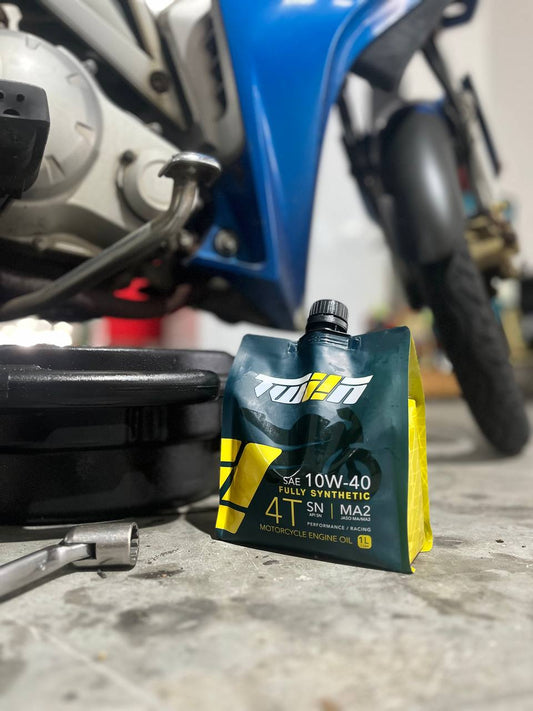What are lubricants?
Any substance the aides in reducing friction between surfaces in contact (to reduce wear and heat generation) is considered a lubricant. Lubricants can be liquid, solid (graphene), gaseous (air) or semisolid (grease).
Depending on the application, lubricants may also function to transmit forces (hydraulic / brake fluids), transporting foreign particles (engine / gear oils), and/or aide in regulating temperature.
Depending on the base oil used, lubricants are also classified as mineral, semi-synthetic or fully synthetic.
What are lubricants made from?
Lubricants are generally made from 2 groups of components:
- Base oils (or Basestocks)
- Additives
Generally, it is about 90% base oils and 10% additives. Additives can be as low as a few % points to as high as 30% of the lubricant content.

Base Oils
API (American Petroleum Institute) has grouped base oils into 5 groups (I, II, III, IV, V). Generally, Gp I, II & III are considered Mineral Oil (refined from crude or other crude derivatives). Gp IV are true synthetic oil. Gp V is a catch all and are for base oils that do not fall into the previous 4 categories.
Although some may view higher groups as superior to the lower classified groups, all base oils have their own benefits and may be preferred over others depending on application.
One of the most important (if not the most important) characteristic / specification of base oils is its viscosity and viscosity index. Viscosity Index or VI is a unitless measure of a fluid’s change in viscosity in relation to temperature. Although a higher VI is considered better, if you are aware of the operating temperature and parameters of your system, you can probably design a lubricant with a lower VI to meet your needs. If a system operates over a wide range of temperatures, a higher VI may be needed. Generally, a lower VI base oil will be more economical and so a trade off needs to be made vs. an ideal high VI lubricant and econs.
Group I (Solvent refined)
These base oils are typically extracted / refined via a method called Solvent Extraction. Gp I base oil tend to be yellowish to brown in color, depending on viscosity and/or producers. Higher viscosity products tend to be darker in color. Some may view a lighter color as “better” which may not always true. Color is not an indication of performance. Instead focus should be on fit for use.
API defines Gp I base oils with greater than 0.03% sulphur and/or less than 90% saturates content. Viscosity index should range between 80 to 120. Due to the lower saturate content, Gp I base oils also are known to have great solubility and are commonly preferred in certain applications such as marine cylinder oil and other industrial oils. Other groups of base oils may require additional additives to overcome the solubility.
Group II (Hydrotreated)
A further refined type of base oil, these were first produced by a process called Hydrotreating. This process removes impurities leading to the base oil being colorless. In present time, Gp II base oils are the most common type of base oils in the market, accounting to about half of all base oils used in lubricant formulations.
API defines Gp II base oils with less than 0.03% sulphur and more more than 90% saturates content. Similar to Gp I, the Viscosity Index will range between 80 to 120. Due to lower impurities, Gp II base oils are preferred in applications such as hydraulic oils. Also, as vehicle emission standards are being more stringent, most contemporary automotive lubricant standards will prefer Gp II base oils over Gp I.
Group III (Hydrocraked)
Undergoing a more intensive form of hydrotreatment called hydrocracking, Gp III base oils are produced with a significant improvement in Viscosity Index.
Gp III are defined similarly to Gp II, but with a much higher Viscosity Index above 120. Gp III base oils will be used in higher performing vehicle engine oil. Despite Gp III not being a true synthetic base oil, lubricants made from these base oils have been marketed as "Synthetic technology" or even be labelled as "Fully Synthetic".
Group IV (Synthetic)
All Polyalphaolefins (PAOs) are typically synthesized in chemical plants and despite API not setting a Viscosity Index range to this group, PAOs tend to have VI ranging from 125 to 200. This will mean that the viscosity of the engine oil will change very little over a wide range of temperature.
This base oil also has exceptionally low pour points and will be found in lubricants used in very cold climate such as northern Europe as well as high heat applications.
Group V (All others)
Gp V is a catchall category and all base oils not falling in the previous 4 groups will fall here. Although the previous categories begin from simply refined (Gp I) to fully synthetic (Gp IV), Gp V should thus not be confused as having incrementally superior specifications. Instead niche base oils with specific properties can be found here such as naphthenic base oils, synthetic esters, polyalkaylene glycols (PAGs), phosphate esters, biolubes, etc.
Gp V base oils are mixed into lubricants formulations to enhance the lubricants properties. A common example will be Ester being mixed with PAO to improve its detergency.
API Base Oil Categories
|
|
Sulfur (%) |
Saturates (%) |
Viscosity Index |
|
Gp I |
> 0.03 |
< 90 |
80 to 120 |
|
Gp II |
< 0.03 |
> 90 |
80 to 120 |
|
Gp III |
< 0.03 |
> 90 |
> 120 |
|
Gp IV |
All PAOs (Polyalphaolefins) |
||
|
Gp V |
All base oils not in Gp I, II, III or IV |
||
Beyond these, there are also some base oils marketed as Gp I+, Gp II+, Gp III+ etc. These are not official API recognized classifications, but are instead used by manufacturers to indicate that these base oils have a Viscosity Index on the higher end of the group's range.
Additives
Very few lubricants can be made without any additives. When added additives will serve at least one of the following purpose:
- Enhance base oil properties
- Suppress undesirable base oil properties
- Impart new properties
Additives are also just that, sometimes more of a particular additive does not improve the desired effect. Some additives may also increase an undesirable property or suppress a desired characteristic. More is not always best, and engineers are careful in how much additives are used. Not only for the above reasons, but also as additives add to the cost of the lubricant significantly.
The more common additives are:
- Anti-oxidants
- Anti-wear agents
- Biocides
- Corrosion inhibitors
- Detergents
- Dispersants
- Emulsifiers / Demulsifiers
- Extreme pressure additivesViscosity index modifiers
- Friction modifiers
- Pour point depressants
- Tackifiers
Some types of Lubricants are:
Automotive
- Engine Oil (4 Stroke)
- Automatic Transmission Fluid
- Gearbox Oil
- Brake Fluid
- Engine Oil (2 Stroke)
- Air Conditioning Compressor Oil
Aviation
- Gas Turbine Engine Oil
- Piston Engine Oil
Marine
- Crosshead Cylinder Oils
- Crosshead Crankcase Oils
- Trunk Piston Oils
- Stern Tube Lubricants
Industrial
- Hydraulic Fluid
- Air / Gas Compressor Oil
- Food Grade Lubricants
- Gear Oils
- Bearing and Circulating Systems Oil
- Refrigerator Compressor Oil
- Steam and Gas Turbine Oil
Definitions
- API – American Petroleum Institute
- SAE – Society of Automotive Engineers
- Saturates - a chemical compound (or ion) that resists the addition reactions, such as hydrogenation, oxidative addition, and binding of a Lewis base. These include Ethane, Propane, etc.
- Hydrotreating - a process for adding hydrogen to the base oil at temperatures above 300°C and pressures above 500 psi in the presence of a catalyst.
- Hydrocracking - a more intense form of hydrotreating. The base oil feed flows over a high-activity catalyst bed at temperatures above 350°C and pressures above 1,000 psi.



